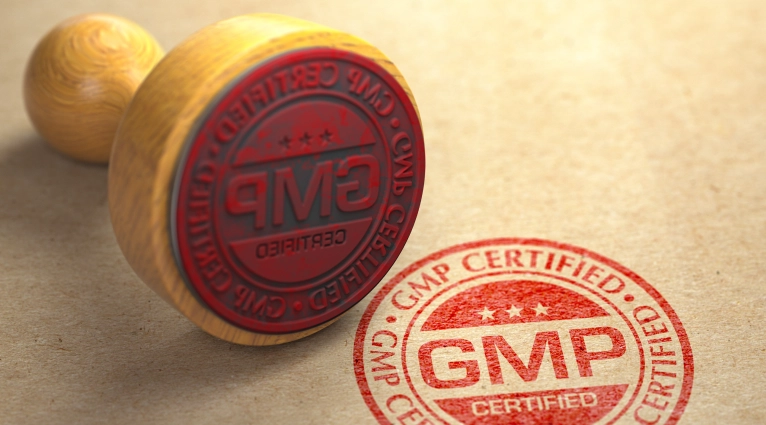What Is GMP?
Good manufacturing practice (GMP) is a set of guidelines enforced by agencies worldwide to regulate pharmaceuticals by ensuring the quality and safety of food, drugs, medical devices, and cosmetics. GMP also minimizes the risks to patients who are involved in any pharmaceutical development. To do this, GMP guidelines direct the proper design, monitoring, and control of manufacturing processes and facilities.

Five Ps of GMP
GMP ensures the consistent quality and safety of products by focusing attention on five key elements:
- 1. People
- 2. Premises
- 3. Processes
- 4. Products
- 5. Procedures (or paperwork)
Let’s jump in and learn:
GMP Resources
Following are links to information about how the major regulatory agencies interpret and monitor drug manufacturers’ compliance with GMP regulations.
GMP Training
GMP guidelines require training because the guidance is expansive. Sec. 211.25 of the FDA’s cGMP outlines personnel qualifications and references training requirements.
- a. Each person engaged in the manufacture, processing, packing, or holding of a drug product shall have education, training, and experience, or any combination thereof, to enable that person to perform the assigned functions. Training shall be in the particular operations that the employee performs and in cGMP related to the employee’s functions. Training in current good manufacturing practice shall be conducted by qualified individuals on a continuing basis and with sufficient frequency to assure that employees remain familiar with CGMP requirements applicable to them.
- b. Each person responsible for supervising the manufacture, processing, packing, or holding of a drug product shall have the education, training, and experience, or any combination thereof, to perform assigned functions in such a manner as to provide assurance that the drug product has the safety, identity, strength, quality, and purity that it purports or is represented to possess.
- c. There shall be an adequate number of qualified personnel to perform and supervise the manufacture, processing, packing, or holding of each drug product.
Organizations can establish a learning curriculum and determine the training frequency for each job as well as for GMP. Many organizations choose to work with third parties for GMP training and certifications. Organizations that offer GMP training and certification programs include:
- NSF International—a non-profit organization
- USP—a non-profit organization
- ECA Academy—established by a not-for-profit organization
GMP Guidelines
Although GMP guidelines are comprehensive, covering everything from materials and labeling to equipment and personnel, they are also meant to be flexible and open-ended. The intention is to allow companies to implement them to optimally suit their manufacturing needs.
GMP guidelines are not prescriptive instructions on how to manufacture products. Instead, they are a series of general principles that must be used in all parts of manufacturing.
As noted, GMP is enforced by a number of authorities, and each has different variations on requirements. However, all guidelines have common principles, including:
- The production and distribution of the drugs must be done to prevent damage and ensure high quality.
- Manufacturing facilities must maintain high standards of hygiene and quality from procurement to product.
- Cross-contamination from labeled or unlabeled material or products must be prevented through manufacturing facility design and operating procedures.
- Environmental conditions must be protected by restricting entry to authorized staff with proper work gear.
- Manufacturing processes must be clearly defined (i.e., written out in a clear and lucid manner) in standard operating procedures (SOP).
- The SOP must be validated and controlled to ensure consistency and compliance with specifications.
- Each step of manufacture and quality control must be recorded by trained staff; it must be demonstrated that all the necessary steps required by the SOP were executed as directed and that the specified quality criteria for the products are met.
- Any deviation from the SOP must be investigated and documented.
- The manufacturing process should remain in a state of control throughout the product lifecycle, with quality-enhancement improvements implemented as needed.
- Traceability (i.e., a complete history of every batch) should be enabled by retaining manufacturing records (including distribution) in a comprehensible and accessible format.
- A system must be in place to recall any batch from sale or supply chain.
- Complaints must be investigated, documented, and remediated; this means uncovering the causes of defects and recording the appropriate mitigation steps and measures taken to prevent a recurrence.
GMP vs. cGMP
GMP is used globally. cGMP originated from and is used by the FDA. The “c” stands for “current.” Most other countries do not include the “c” as it is assumed that manufacturers will keep up to date on GMP guidelines and adapt as new technology and other innovations are available. The FDA uses cGMP to highlight the need for manufacturers to stay current and not stick with outmoded practices.
The requirements for cGMP are flexible and, to some degree, are open-ended to give manufacturers the latitude to decide the best way to implement quality controls. It also encourages manufacturers to use all available resources and approaches to improve and achieve higher quality continually. Following the “c” in cGMP means that companies must use up-to-date systems and technology to comply with the regulation.
Inspections and Enforcement
GMP Inspections
GMP pharmaceutical manufacturing inspections are conducted worldwide. Inspectors visit facilities where drugs are manufactured or stored and assess all aspects of the facility related to GMP. This includes equipment, finished and unfinished materials, personnel, containers, and labeling.
The procedures for GMP inspections differ based on the authority conducting the inspections, but all follow a standard approach and are led by trained staff. In addition to on-site inspections, GMP inspectors also consider and take action based on reports of potential violations provided by the public and other agencies.
Scope of FDA GMP Inspections
The FDA may not inspect:
- Financial information
- Internal audit reports
- Personnel data (except for qualifications of technical and professional personnel)
- Pricing information
- Reports and memos on factory inspections
- Research data (except for new drugs)
- Sales data (other data related to shipping)
- Shipping records
GMP Enforcement
The impact of non-compliance with GMP is significant. As noted above, GMP rules vary by authority.
To get a sense of the gravity of non-compliance, consider the FDA’s cGMP enforcement capabilities. Failure to comply with cGMP results in cascading enforcement actions by the FDA, including:
- Warning letter
Enumerates the cGMP violations and asks for an explanation of how the issue will be fixed. - FDA seizure of products
Court action is undertaken to have the company remove the product from the market, because if a company is not complying with cGMP regulations, any drug it makes is considered “adulterated” under the law. - Civil injunction
A court prohibits some or all further sales and/or issues a recall for a product already on the market. - Civil action
The FDA takes an individual and/or company to court to halt the production or distribution of a product manufactured or sold in violation of cGMP. - Shut-down order
The FDA issues an order for the company to comply with cGMP before resuming sales. - Preclusion of government contracts
The FDA publishes an unacceptable product evaluation when cGMP violations warrant an enforcement action. - Import alerts
The FDA flags products imported from a country, manufacturer, or shipper that show a pattern of cGMP violations. - Criminal liability
The FDA holds the company and/or individual employees criminally responsible for cGMP violations. Potential consequences include:- Disgorgement of profits
- Fines
- Jail time
- A misdemeanor conviction for a first offense, if there was no intent to defraud or mislead
- Felony conviction after a previous conviction or commission of a prohibited act with intent to defraud or mislead
- Restitution to consumers
Why GMP Is Important
GMP guidelines enable consistent quality of a product and help identify risks associated with poor quality products. GMP also supports consumer and environmental health.
Compliance with GMP benefits companies and consumers. Companies can reduce the number of batch recalls and decrease the number of adverse reactions reported in patients, and consumers benefit from safer and more effective products.
Egnyte has experts ready to answer your questions. For more than a decade, Egnyte has helped more than 16,000 customers with millions of customers worldwide.
Last Updated: 5th December, 2021



